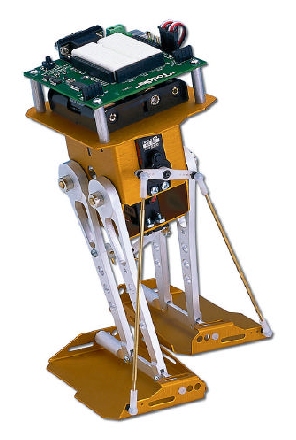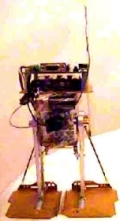
 |
Parallax Toddler Robot kit
|
tech sector |

The Toddler is the logical extension to the application
of microcontrollers to small robotics. The
10" tall bipedal robot reminds me lightly of a distant
predecessor of Watto's repair droids from
Star Wars, incorporates two microservos, an
integrated controller board, and a remarkable
spacious prototyping area on the upper platform.
This prototyping area allows hobbyists to interface
the embedded Stamp II to a number of sensors,
modules, and chips for flexibility, and students
to freely experiment with control devices to
drive the Toddler.
One of the most impressive aspects of the
Toddler is the degree of detail and craftsmanship
Parallax put into creating this kit. It arrives in a
large hinged poly project box with all parts, a
Stamp programmer's reference, support soft-ware,
and classroom manual for the construction
and experimentation with the Toddler. The parts
are all well labeled and impeccably crafted from
machined and anodized aluminum, creating a
robot that is really attractive as well as functional.
The kit went together in an afternoon in a college hallway, and it was running around terrorizing the Intelligent Agent editorial cats by the evening. The fit of all parts was exceptional, which lent greatly to the speed of construction. The only problem I had with construction was that one of the servos centered so that the tilt control horn was slightly off from 180 degrees, but this was due to the servo's construction, and was easily remedied with adjustments of the control arms.
After that, it was time to begin programming the new arrival to become ambulatory. The classroom manual, and Parallax has framed the process well as being one of learning, explains clearly bout various techniques to sole the problem of walking from brute force to much more efficient state-transition analysis. After learning the basics of walking, the learner has the option of experimenting with various sensing techniques, maneuvers such as object detection and following, and is then invited to consider more advanced techniques through the addition of Parallax AppMod kits.
ROAD TEST
However, we wanted to get our bot 'on
the road.' What we did was to mount it
with a video camera with transmitter
and extra 9 volt battery to run the transmitter
and camera. The camera was a
simple lightweight black and white CCD,
and the transmitter was a high power
Cube from Ramsey Electronics. As the
test drive didn't require a lot of sensing,
no detectors were installed. However, in our haste to experiment,
the battery we strapped to the platform
was dead, so instead of removing it, we thought we'd
try just taping another battery to the platform.
The results were excellent. The
Toddler bore the 6 ounce load with no sign of instability
or even much encumbrance.


The Toddler is an excellent choice for students, experimenters and experimental artists that has excellent documentation, ability for use as a microcontroller and robotics trainer, and interesting possibilities for limited installation/remote observation/telepresence. The embedded controller platform contains ample space for electronic experimentation, and the servo configuration allows for more than adequate strength when com-pared to other robots in its class.